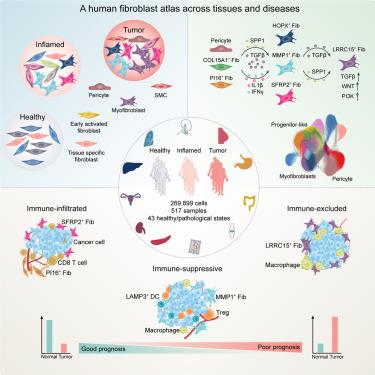当前位置:
X-MOL 学术
›
Cancer Cell
›
论文详情
Our official English website, www.x-mol.net, welcomes your
feedback! (Note: you will need to create a separate account there.)
Cross-tissue human fibroblast atlas reveals myofibroblast subtypes with distinct roles in immune modulation
Cancer Cell ( IF 48.8 ) Pub Date : 2024-09-19 , DOI: 10.1016/j.ccell.2024.08.020 Yang Gao, Jianan Li, Wenfeng Cheng, Tian Diao, Huilan Liu, Yufei Bo, Chang Liu, Wei Zhou, Minmin Chen, Yuanyuan Zhang, Zhihua Liu, Weidong Han, Rufu Chen, Jirun Peng, Linnan Zhu, Wenhong Hou, Zemin Zhang
Cancer Cell ( IF 48.8 ) Pub Date : 2024-09-19 , DOI: 10.1016/j.ccell.2024.08.020 Yang Gao, Jianan Li, Wenfeng Cheng, Tian Diao, Huilan Liu, Yufei Bo, Chang Liu, Wei Zhou, Minmin Chen, Yuanyuan Zhang, Zhihua Liu, Weidong Han, Rufu Chen, Jirun Peng, Linnan Zhu, Wenhong Hou, Zemin Zhang

|
Fibroblasts, known for their functional diversity, play crucial roles in inflammation and cancer. In this study, we conduct comprehensive single-cell RNA sequencing analyses on fibroblast cells from 517 human samples, spanning 11 tissue types and diverse pathological states. We identify distinct fibroblast subpopulations with universal and tissue-specific characteristics. Pathological conditions lead to significant shifts in fibroblast compositions, including the expansion of immune-modulating fibroblasts during inflammation and tissue-remodeling myofibroblasts in cancer. Within the myofibroblast category, we identify four transcriptionally distinct subpopulations originating from different developmental origins, with LRRC15+ myofibroblasts displaying terminally differentiated features. Both LRRC15+ and MMP1+ myofibroblasts demonstrate pro-tumor potential that contribute to the immune-excluded and immune-suppressive tumor microenvironments (TMEs), whereas PI16+ fibroblasts show potential anti-tumor functions in adjacent non-cancerous regions. Fibroblast-subtype compositions define patient subtypes with distinct clinical outcomes. This study advances our understanding of fibroblast biology and suggests potential therapeutic strategies for targeting specific fibroblast subsets in cancer treatment.
中文翻译:

跨组织人成纤维细胞图谱揭示了在免疫调节中具有不同作用的肌成纤维细胞亚型
成纤维细胞以其功能多样性而闻名,在炎症和癌症中起着至关重要的作用。在这项研究中,我们对来自 517 个人类样本的成纤维细胞进行了全面的单细胞 RNA 测序分析,涵盖 11 种组织类型和不同的病理状态。我们鉴定了具有普遍和组织特异性特征的不同成纤维细胞亚群。病理条件导致成纤维细胞组成的显着变化,包括炎症期间免疫调节成纤维细胞的扩增和癌症中组织重塑肌成纤维细胞。在肌成纤维细胞类别中,我们确定了四个转录不同的亚群,它们起源于不同的发育起源,其中 LRRC15 + 肌成纤维细胞显示出终末分化的特征。LRRC15 + 和 MMP1 + 肌成纤维细胞都显示出促肿瘤潜力,有助于免疫排斥和免疫抑制肿瘤微环境 (TME),而 PI16 + 成纤维细胞在邻近的非癌性区域显示出潜在的抗肿瘤功能。成纤维细胞亚型组成定义了具有不同临床结果的患者亚型。这项研究促进了我们对成纤维细胞生物学的理解,并提出了在癌症治疗中靶向特定成纤维细胞亚群的潜在治疗策略。
更新日期:2024-09-19
中文翻译:

跨组织人成纤维细胞图谱揭示了在免疫调节中具有不同作用的肌成纤维细胞亚型
成纤维细胞以其功能多样性而闻名,在炎症和癌症中起着至关重要的作用。在这项研究中,我们对来自 517 个人类样本的成纤维细胞进行了全面的单细胞 RNA 测序分析,涵盖 11 种组织类型和不同的病理状态。我们鉴定了具有普遍和组织特异性特征的不同成纤维细胞亚群。病理条件导致成纤维细胞组成的显着变化,包括炎症期间免疫调节成纤维细胞的扩增和癌症中组织重塑肌成纤维细胞。在肌成纤维细胞类别中,我们确定了四个转录不同的亚群,它们起源于不同的发育起源,其中 LRRC15 + 肌成纤维细胞显示出终末分化的特征。LRRC15 + 和 MMP1 + 肌成纤维细胞都显示出促肿瘤潜力,有助于免疫排斥和免疫抑制肿瘤微环境 (TME),而 PI16 + 成纤维细胞在邻近的非癌性区域显示出潜在的抗肿瘤功能。成纤维细胞亚型组成定义了具有不同临床结果的患者亚型。这项研究促进了我们对成纤维细胞生物学的理解,并提出了在癌症治疗中靶向特定成纤维细胞亚群的潜在治疗策略。


















































 京公网安备 11010802027423号
京公网安备 11010802027423号